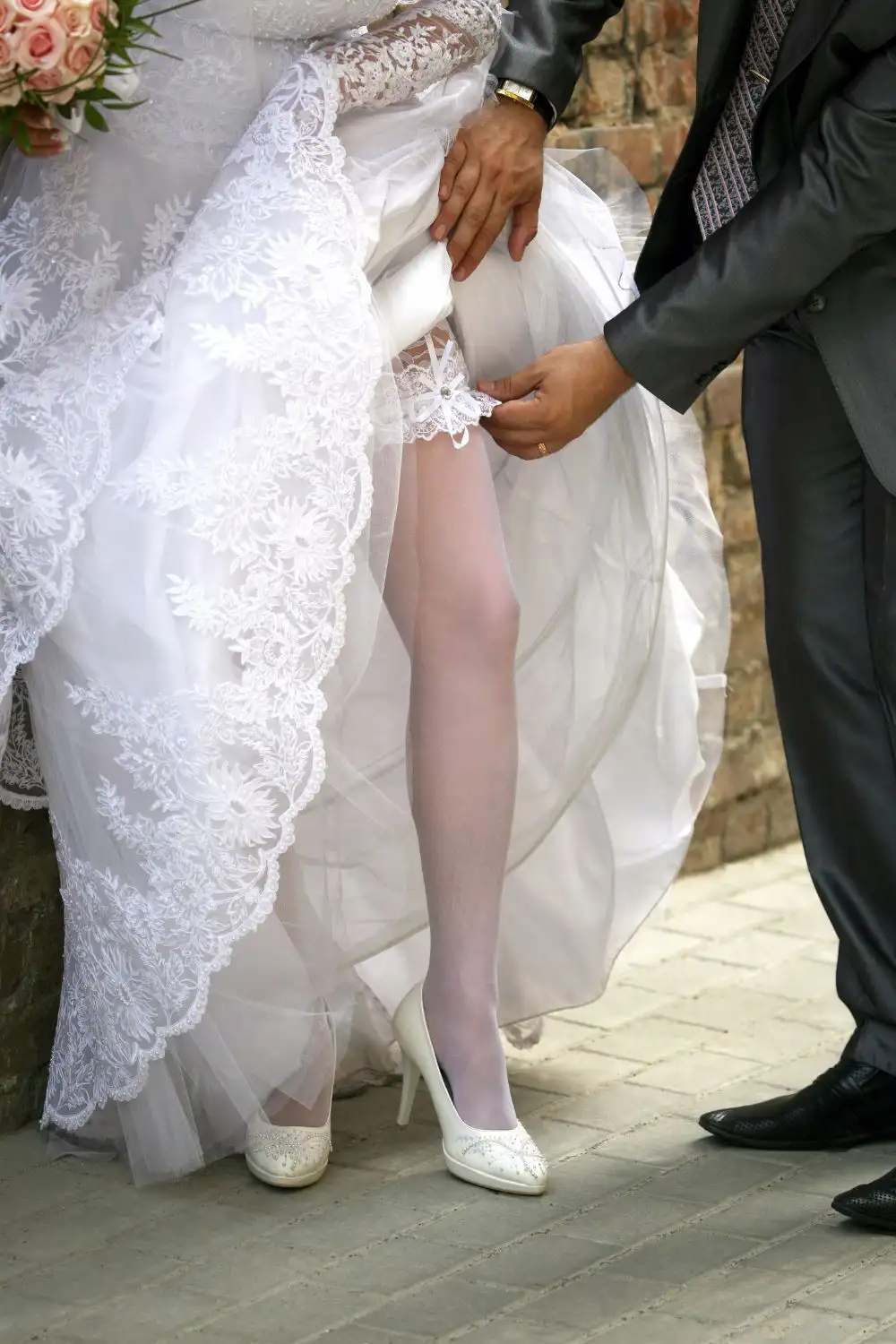When it comes to fashion, function often follows form. And when it comes to ladies’ garters, form and function have long gone hand in hand. For as long as garters have graced women’s legs – enduring centuries of changing fashions – the main reasons for wearing them have remained largely the same.
Traditionally, garters were used as a practical way to keep stockings from falling. Before the invention of elastic, there were no easy options to ensure stockings stayed up, so enterprising women began fastening strips of fabric around their legs to grip the stocking tops.
And while elastic bands have since made garters less essential for hitching up the hose, they remain a comfortable and surefire solution for stocking support.
But garters’ origins in function belies their growth into a full-fledged symbol of femininity and allure. What began as a necessary foundation for fashionable dressing evolved into its own fashion statement.
The strip of plain fabric winding enticingly around a woman’s leg became imbued with layers of meaning linked to intimacy, seduction, and power.
Today, as weddings still incorporate the garter toss ritual and lingerie sets feature garter belts, form has certainly taken precedence over function for many ladies who wear them.
Yet, at their core, garters remain rooted in both aesthetic appeal and practicality, combining fashion with functionality in one sleek accessory. From the boudoir to the bridal suite, garters embrace the duality of women themselves – balancing strength and sensuality, control, and carefree charm.
And so these simple bands endure, transforming the everyday act of getting dressed into an expression of feminine grace, spirit, and style.
Why do ladies wear garters?
Practical Purpose
Ladies wear garters primarily for practical purposes. Historically, garters helped keep stockings up for women when elastic was not invented.
Without garters, stockings made of non-stretchy fabrics would easily slip down, especially when sitting or walking. Garters and garter belts with straps attached to stockings helped solve this problem by holding the stockings up.
Even today, garters provide a more secure and comfortable option than elastic bands for holding up stockings, especially for women with larger thighs.
Elastic alone may not offer enough support, so garters are still useful for practical purposes. Wearing garters allows women to avoid the annoyance of constantly hitching up their stockings or having them slip and slide.
While garters serve fashionable purposes, their original and fundamental reason for existing was the practical need to keep stockings secure before the advent of elastic. Garters allow women to wear stockings comfortably throughout the day without worrying about them slipping down.
Practicality and function drove the creation of garters, though fashion has since also become a reason why some women wear them.

Fashion Statement
Garters have long served as a fashion accessory for women, accentuating outfits with a touch of allure and femininity. Many ladies wear garters not just for practical purposes but to make a statement and enhance their aesthetic appeal.
Since their invention, garters have been seen as a sexy and sophisticated addition to women’s fashion. They became especially trendy in the 20th century as the lingerie industry grew.
Whether visible under short skirts or hidden underneath clothes, garters convey an air of mystery that draws the eye and mind.
The simple bands of fabric or elastic accentuate a woman’s legs by drawing the gaze upwards. They create the promise of undiscovered secrets beneath the outwardly proper clothing.
By hinting at what lies under the visible surface, garters imbue an outfit with a sensual note, even in the most chaste fashions.
Garters add a subtle flourish that can make an otherwise plain dress or stockings into a dramatically elegant and feminine statement. The bolder styles featuring jewels or decorative straps fashioned of rich materials demonstrate the wearer’s sense of style and self-assurance.
Throughout their long history, garters have remained a popular accent for women seeking to enhance the aesthetic appeal of their attire with a touch of classic chic.
Whether serving their original functional purpose or simply being used as an alluring accessory, garters provide women with a simple yet powerful way to express confidence, poise, and femininity through fashion.
Wedding Tradition
The wedding garter is an iconic part of a bride’s attire, representing an age-old tradition for the newlywed couple. For centuries, brides have incorporated garters into their wedding day outfits to symbolize intimacy and good fortune in marriage.
The custom of the groom removing and tossing the garter to guests at the reception signifies the transition into married life and is meant to bring good luck.
Some believe the tradition originated in medieval times when guests would try to tear pieces of the bride’s dress for luck, and the garter offered an alternative.
During the wedding reception, the groom typically removes the garter from the bride’s leg in a light-hearted and playful manner, often using his teeth. He then tosses the garter to the group of unmarried male guests. The man who catches it is said to be the next to wed. This “garter toss” mirrors the tradition of the bride tossing her bouquet to unmarried female guests.
Together, the garter and bouquet tosses signify that the couple’s luck and good fortune in marriage will rub off on the next lucky singles to wed.
For the newlyweds, the garter represents intimacy within marriage and offers them a moment of levity and connection on their wedding day.
While the garter tradition has evolved over time, the symbolism remains the same – a bride’s garter is both a fashion statement and a representation of the promises made on her wedding day.
By incorporating the garter into her ensemble, the bride honors tradition and embraces the commitment and fun ahead in married life.
Sentimental Value
For some brides, the garter they wear on their wedding day holds deep personal meaning that imbues the accessory with sentimental value.
Choosing a garter with a family history or a story to tell can make it a cherished heirloom and a meaningful part of the bride’s attire.
Many sentimental garters have been passed down through generations. A garter that belonged to the bride’s grandmother or great-grandmother and was worn on her wedding day can connect the bride to her female ancestors in a tangible way. Such garters represent the continuity of cherished traditions and the bonds of family.
For other brides, a garter made from a sentimental fabric can hold special significance. A garter sewn from the fabric of the bride’s mother’s wedding dress, for example, literally ties the two women together on their shared special day.
Wearing such a garter woven from a loved one’s fondest memories can make the bride feel close to her emotional support system on her big day.
Lastly, a garter that is gifted or contributed to by the bride’s loved ones, such as bridesmaids, can be imbued with their collective love, friendship, and blessings for the marriage.
The collaborative effort that goes into creating or selecting the garter represents the sum of the community that nurtured and supported the bride on her journey to the altar.
Whether inherited, crafted from a memento, or bestowed as a gift, a garter with sentimental value can enhance the meaningfulness of a bride’s wedding outfit.
The story behind the garter becomes a part of the new story that the bride and groom write together as wife and husband.

Personal Pleasure
For some women, wearing garters is a matter of personal preference driven by feelings of comfort, confidence, and allure. Garters make these women feel sexy, powerful, and controlled by their fashion choices.
Many women find garters to be comfortable and secure. The firm yet flexible fabric gently hugs the thigh, holding stockings up without constriction. The familiar sensation provides a comforting sense of normalcy and routine.
At the same time, seeing garters peeking out unexpectedly or knowing their hidden presence under clothing can imbue an outfit with allure.
Wearing garters allows women to embrace their sexuality and femininity on their own terms. The thrill of something personally titillating yet outwardly proper empowers women, boosting their confidence.
Garters come in various styles to suit different tastes, from lacy to leather. Women can choose garters that match their personality, expressing their individuality through fashion.
No matter the design, garters celebrate women’s bodies by highlighting a feature – legs – long associated with traditional notions of femininity.
Ultimately, whether or not to wear garters remains a personal choice based on comfort, confidence, and aesthetic sense.
For some women, garters bring pleasure through practicality, security, and quiet self-assurance. For others, garters serve as a statement of independence, allowing women to assert control over cultural norms and redefine what feels right for them.
Wearing garters becomes an act of personal empowerment that imbues everyday routines with sexuality, satisfaction, and joy.
Empowerment
For women who choose to wear them, garters can be a symbol of empowerment and an act of reclaiming control over their own bodies.
By wearing garters, women assert their right to express their sensuality on their own terms and challenge societal norms that seek to repress female sexuality.
For centuries, women have been told how to dress and behave in ways that suppress and shame their sexuality.
Culturally, women’s bodies have often been viewed as belonging more to men than to themselves. Garters provide a way for women to push back against this oppression by openly embracing their sexuality.
When a woman puts on a garter, she is making a statement. She declares that her body is her own and that she is comfortable with her desires and attractiveness.
Wearing garters makes women reject the idea that their sexuality should be hidden or controlled. They refuse to be shamed for the very traits that make them feminine.
For these women, garters serve as a symbol of empowerment. In choosing to wear them, women take ownership and authority over cultural norms that seek to constrain female sexuality.
By wearing garters without apology, women demonstrate self-assurance and assert the basic human right to make their own choices about their bodies and how they are presented to the world.
Garters allow women to reclaim their bodies on their own terms, imbuing even the most conventional of outfits with a sense of resistance, courage, and strength. For these women, garters represent a personal declaration of independence, freedom, and self-possession.
Part of a Lingerie Set
For many women, wearing garters as part of a matching lingerie ensemble heightens intimacy and allure during romantic interludes.
Combining garters, stockings, and coordinating undergarments creates a look that exudes confidence, sensuality, and femininity- qualities that enhance closeness and connection in relationships.
Various types of lingerie sets incorporating garters allow women to choose an aesthetic that suits their personal style and the tone of the occasion.
Options ranging from delicate lace and silk to satin and leather cater to different tastes and moods. Whether the goal is playful seduction or sultry sophistication, garters provide the final flourish that completes an alluring yet comfortable at-home outfit.
Regardless of the details, lingerie sets featuring garters empower women to present themselves as peaceful yet powerful – relaxed yet ready to charm and be charmed.
The feminine strength that comes from being comfortably clothed transforms intimacy from a physical act into a celebration of the spirit within.
For the woman wearing the garters, coordinating undergarments allow her to embody her most confident self. The brazenness required to be so boldly and beautifully dressed balances bashfulness when it comes to exposed flesh, fostering an attitude of mutual trust and pleasure between partners.
For the partner, the invitation to part away layers of lingerie reveals not merely skin but all that the woman holds inside her hopes, vulnerabilities, and desires.
What begins as attraction becomes affection as physical intimacy also unveils emotional and spiritual intimacy.
Together, garters and their accompanying underthings catalyze profound closeness when worn with the right intention. They transform ordinary moments into opportunities for two souls to see and be seen, truly and tenderly, as one.

Summary
Ladies wear garters for various reasons. Historically, garters served the practical purpose of keeping stockings up before elastic was invented. Today, garters still provide secure support and comfort for stockings.
However, garters have also become a fashion statement, expressing sensuality and allure. For some brides, the wedding garter holds sentimental value, connecting them to family tradition. For some women, garters provide personal pleasure by boosting confidence and embracing femininity.
Garters can also empower women by allowing them to express their sexuality on their own terms. For many, garters as part of lingerie sets heighten intimacy during romantic moments.
FAQ
When did garters become popular?
Garters became popular in the 1940s to the early 1960s when women wore them as fashionable accessories. Originally used by both men and women to hold up socks, garters evolved to be worn as garter belts around women’s waists to keep stockings up. These belts were designed in the 1920s as a lighter, more fashionable alternative to corsets and girdles.
Who started the garter tradition?
In ancient times, wedding guests would accompany the bride and groom to their bedroom, and it was considered good luck for a guest to take home a piece of the bride’s clothing, leading to the tradition of the garter. The garter toss at weddings originated in 14th-century France, where the groom would toss the bride’s garter to guests as evidence of consummation.
Why is a garter only worn on one leg?
A garter is typically worn on one leg for practical purposes, originally used to hold up stockings or socks. However, today, garters are often worn as a fashion statement, and there is no specific “right” leg to wear it. Brides, for example, can choose to wear the garter on either their left or right leg based on personal preference. Some brides wear two garters, one to toss and one to keep as a memento.
How to choose the right size garter belt?
To choose the right size garter belt, measure your waist and hips using a measuring tape. Check the brand’s sizing chart, as sizes may vary across different brands. Opt for a garter belt with adjustable elastic straps for a better fit. Ensure the garter belt fits comfortably on your waist and sits securely, with slightly longer straps in the back. Consider your needs and preferences before purchasing, such as whether you need everyday comfort or a retro-shaping effect.
Why is the garter Toss controversial?
The garter toss tradition can be controversial due to various reasons. Some perceive it as tacky or embarrassing, while others believe it singles out single individuals or pressures them to participate. Critics argue that the tradition is sexist and objectifies women, perpetuating gender roles and treating women as objects to be won. The historical roots of the tradition of sexual conquest and objectification can be offensive to some. Brides may choose not to wear a garter or participate due to personal discomfort or conflicting values. Ultimately, the controversy arises from differing perspectives and beliefs.



